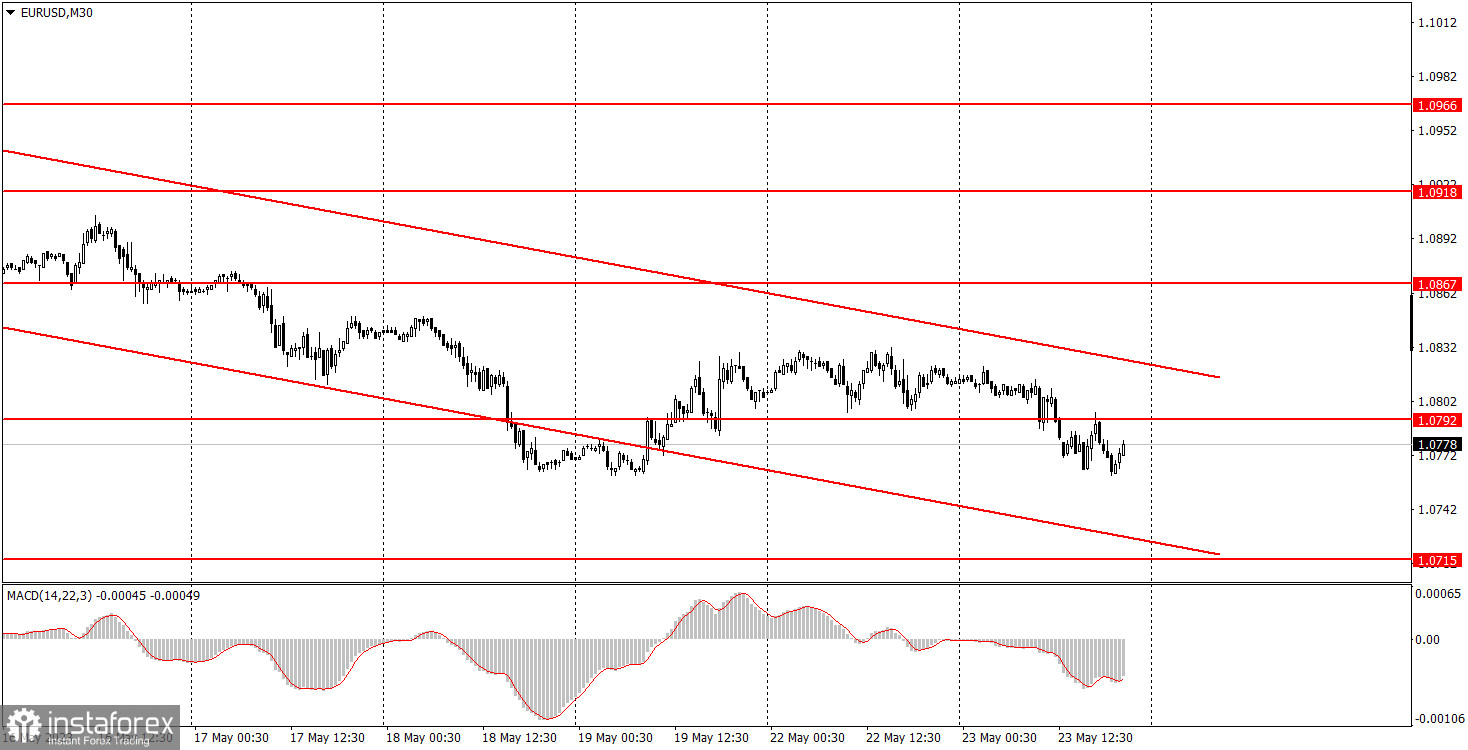Analysis of macro data:

On Wednesday, there will be no macro data in either the European Union or the United States. Furthermore, all fundamental events that could theoretically impact the pair's movement are scheduled for the evening, which is when novice intraday traders are expected to leave the market. The only notable event is perhaps the release of the minutes from the latest Federal Reserve meeting, but such documents rarely contain important information. We will only learn how many members of the monetary committee supported the rate hike during the May meeting. However, this information is unlikely to have a significant impact on the US dollar. Overall, the pair should continue to fall regardless of the macroeconomic backdrop.
Fundamental events:

However, there will be several fundamental events on Wednesday. First and foremost, it is worth taking note of European Central Bank President Christine Lagarde's speech. We don't expect any bold statements from her, and the market clearly knows what to expect from the central bank in the coming months, but sometimes there are still unexpected remarks along the way. In the United Kingdom, Bank of England Governor Andrew Bailey will deliver a speech. He has already spoken with his banking colleagues in Parliament. Most likely, Wednesday's speech will be similar but before a different committee. Therefore, there is no need to anticipate new comments and statements. However, Bailey's speech is the only one scheduled for the daytime rather than the evening, so the market could still react to it.
In the United States (also in the evening), one of the members of the Federal Reserve's monetary committee, Christopher Waller, will deliver a speech. Over the past two weeks, we have seen quite a few similar speeches by Fed officials, but no one has reported anything that could provoke an immediate reaction. At the same time, several Fed representatives have suggested a more significant rate hike, which could support the US dollar in the background.
General conclusions:
Wednesday's calendar includes several important events. We would highlight the speeches by Bailey and Lagarde. Since volatility is relatively weak at the moment, the reaction to the speeches may also be mild. However, there is a small chance that the speakers could reveal new information that can trigger more significant movements.
Basic rules of the trading system:
1) The strength of the signal depends on the time period during which the signal was formed (a rebound or a break). The shorter this period, the stronger the signal.
2) If two or more trades were opened at some level following false signals, i.e. those signals that did not lead the price to Take Profit level or the nearest target levels, then any consequent signals near this level should be ignored.
3) During the flat trend, any currency pair may form a lot of false signals or do not produce any signals at all. In any case, the flat trend is not the best condition for trading.
4) Trades are opened in the time period between the beginning of the European session and until the middle of the American one when all deals should be closed manually.
5) We can pay attention to the MACD signals in the 30M time frame only if there is good volatility and a definite trend confirmed by a trend line or a trend channel.
6) If two key levels are too close to each other (about 5-15 pips), then this is a support or resistance area.
How to read charts:
Support and Resistance price levels can serve as targets when buying or selling. You can place Take Profit levels near them.
Red lines are channels or trend lines that display the current trend and show which direction is better to trade.
MACD indicator (14,22,3) is a histogram and a signal line showing when it is better to enter the market when they cross. This indicator is better to be used in combination with trend channels or trend lines.
Important speeches and reports that are always reflected in the economic calendars can greatly influence the movement of a currency pair. Therefore, during such events, it is recommended to trade as carefully as possible or exit the market in order to avoid a sharp price reversal against the previous movement.
Beginners should remember that every trade cannot be profitable. The development of a reliable strategy and money management are the key to success in trading over a long period of time.
 English
English 
 Русский
Русский Bahasa Indonesia
Bahasa Indonesia Bahasa Malay
Bahasa Malay ไทย
ไทย Español
Español Deutsch
Deutsch Български
Български Français
Français Tiếng Việt
Tiếng Việt 中文
中文 বাংলা
বাংলা हिन्दी
हिन्दी Čeština
Čeština Українська
Українська Română
Română

